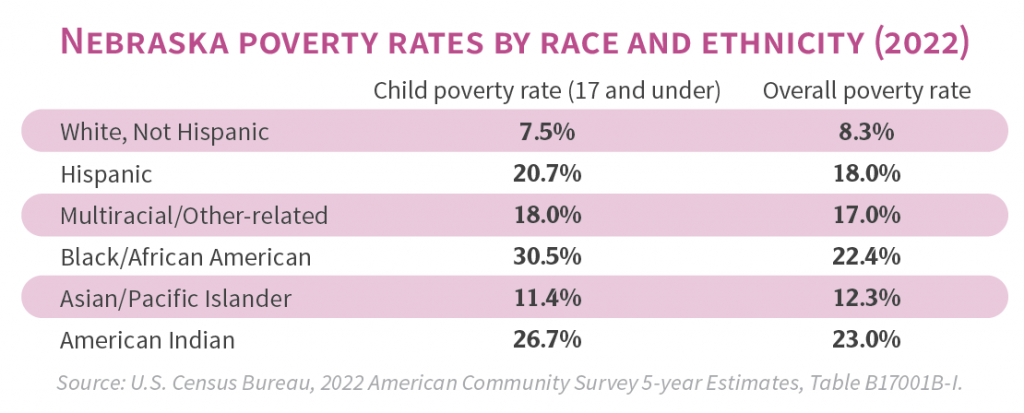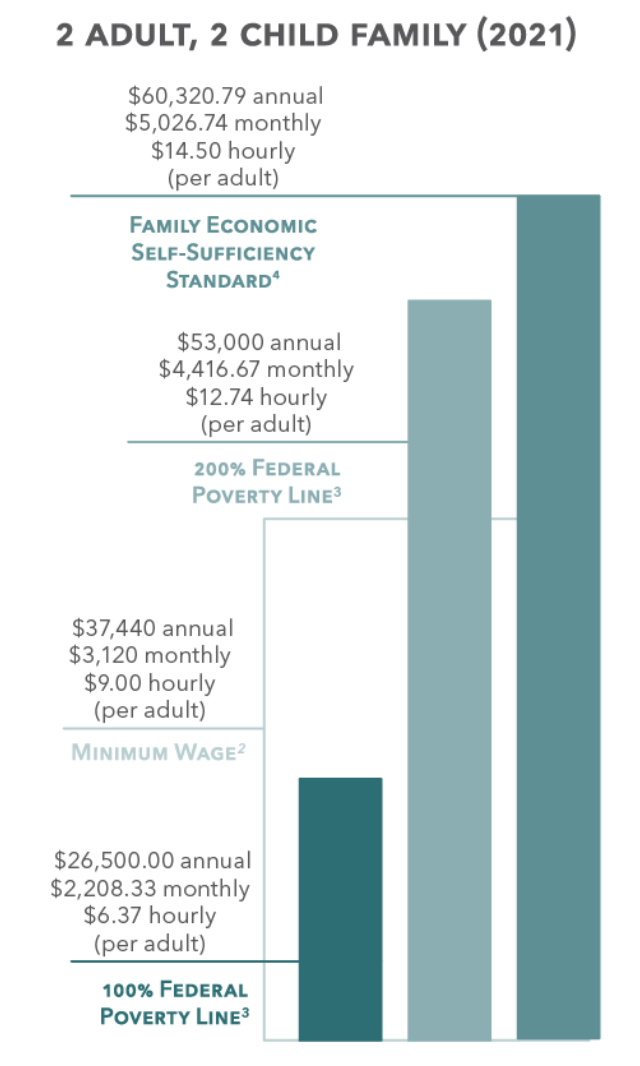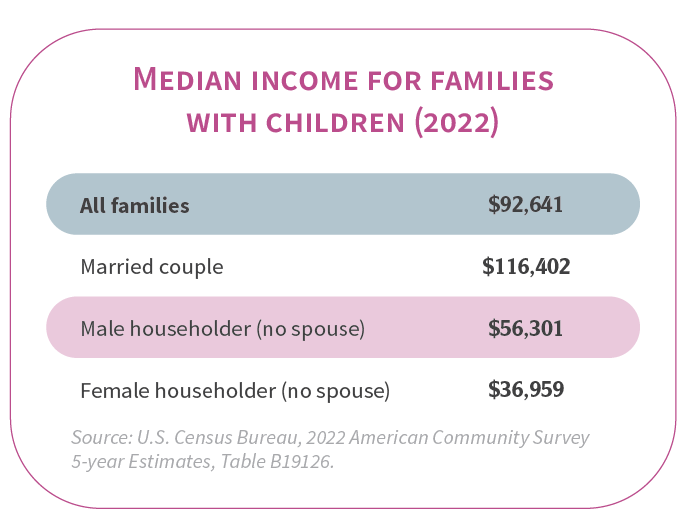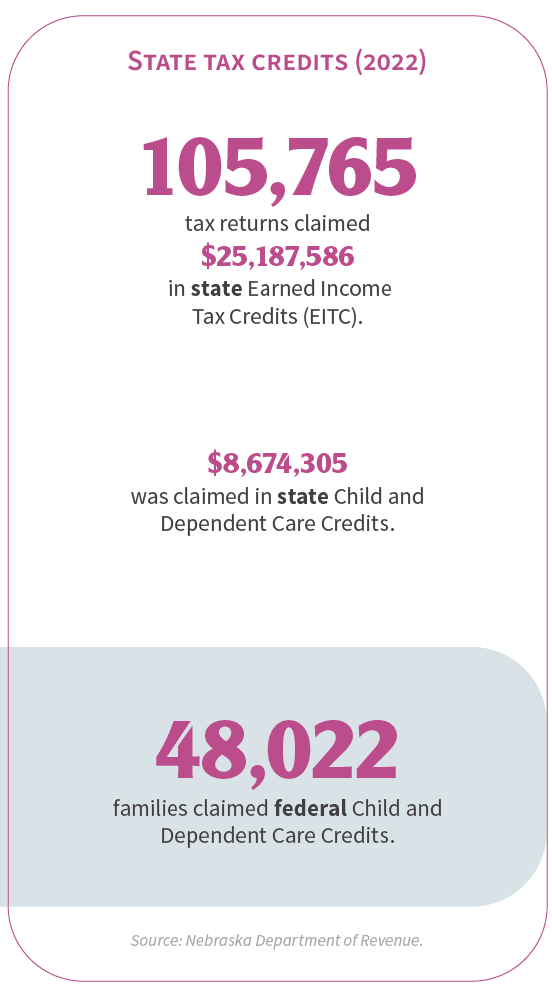Our children, communities, and state are stronger when all of Nebraska’s families are able to participate fully in the workforce and establish financial security. We must ensure that families are able to meet their children’s basic needs and save for the future. A robust system of supports should help families make ends meet as they work toward financial independence. Hardworking families should have a fair share in the success of our state’s economy. When families need assistance in meeting the basic needs of their children, public benefit programs should work efficiently and effectively to provide a safety net for temporary challenges. Parents should not have to choose between the job they need and the family they love. All families should have the opportunity to invest in their children’s future and be able to access community resources that are well-funded by fair tax policies.
Poverty
Nebraska poverty (2010-2022)1
- Poverty rate for children
- Poverty rate for families with children
- Poverty rate for all persons
- Poverty rate for children
- Poverty rate for families with children
- Poverty rate for all persons
33.3%
of children living in single-mother households are in poverty.2
13.7%
of children living in single-father households are in poverty.2
5.3%
of children living in married-couple households are in poverty.2
17.0% of children living with a grandparent and without a parent present are in poverty.2
23,859 of which were in extreme poverty (<50% of the Federal Poverty Line).3


1. U.S. Census Bureau, 2010-2022 American Community Survey 5-year estimate, Tables B17001, S1702.
2. U.S. Census, 2022 American Community Survey 5-year estimate, Tables B17006, S1001.
3. U.S. Census, 2022 American Community Survey 5-year estimate, Table B17024.
4. U.S. Department of Health and Human Services , 2022 HHS Poverty Guidelines.
Making Ends Meet
Making ends meet
Nebraskans pride themselves on being hard-working people. In 2022, 77.6% of children in our state had all available parents in the workforce.1 Unfortunately, having high labor force participation doesn’t always translate into family economic stability.
The chart at right illustrates the gap between low-wage earnings and the amount needed to provide for a two-parent family with two children. It assumes that both parents work full-time (40 hours a week), year round (52 weeks per year). That means no vacation, no sick time, just work.
The federal poverty level doesn’t describe what it takes for working families to make ends meet. For that we turn to the Family Economic Self-Sufficiency Standard (FESS). The FESS uses average costs, like fair median rent and the average price of a basic menu of food, to calculate what a family needs to earn to meet its basic needs without any form of private or public assistance. It does not include luxuries like dining out or saving for the future.



1. U.S. Census, 2022 American Community Survey 5-year Estimates, Table B23008.
2. Voices for Children in Nebraska, Family Bottom Line.
3. U.S. Department of Labor.
4. HH Poverty Guidelines for 2022.
5. Financial Services, Operations, Nebraska Department of Health and Human Services.
6. U.S. Census Bureau, Annual Estimates of the Resident Population by Single Year of Age and Sex: April 1, 2020 to July 1, 2022.
7. Financial Services, Operations, Nebraska Department of Health and Human Services.
Housing & Homelessness
Homelessness
The Nebraska Homeless Assistance Program (NHAP) and the Housing and Urban Development Program (HUD) serves individuals who are experiencing homelessness or near homeless. Not all people experiencing homelessness receive services.
In 2021, HUD/NHAP served
11,501
homeless individuals.
2,239
homeless children ages 18
and under.
3,555
homeless families with children.
18
unaccompanied homeless children.
3,294
individuals at risk of homelessness.
1,373
children at risk of homelessness.
2,229
families with children at risk of homelessness.
0
unaccompanied children at risk of homelessness.
Source: Nebraska Center on Children, Families and the Law
In 2021, Nebraska Public Housing had:4
- 7,108 public housing units.
- 13,308 vouchers.
- 4,650 units were 1 bedroom (non-family).
Housing of Nebraska children in 2022:
- 40,000 (8%) children lived in crowded housing.5
- 105,000 children (22%) lived in households with a high housing cost burden.5
- 82,000 children (55%) were low-income with a high housing cost burden.5
Homeownership
70.8% of families with children owned their home in 2022.1
Housing
24.7%
of Households were moderately-burdened
(30-50% income on rent) by housing costs in 2022.2
21.9%
of Households were severely-burdened
(>50% income on rent) by housing costs in 2022.3

1. U.S. Census Bureau, 2022 American Community Survey 5-year Estimates, Table B25115.
2. U.S. Census Bureau, 2022 American Community Survey 1-year Estimates, Table B25070.
3. U.S. Census Bureau, 2022 American Community Survey 1-year Estimates, Table B25071.
4. Nebraska Office of Public Housing, HUD.
5. Annie E. Casey Foundation, Kids Count Data Center
Hunger

Food insecure households in Nebraska (2011-2022)1
Approximately 97,647 households in Nebraska were food-insecure in 2022. This means that someone in the household has disrupted their eating patterns or reduced their intake of food because there was not enough food in the house to eat.
12% of Nebraska children experienced food insecurity (2021).2
68% of food insecure children are likely eligible for federal nutrition assistance (2021).2
2. Feeding America, Map the Meal Gap, Child Food Insecurity in Nebraska, 2021.
SNAP & WIC
Supplemental Nutrition Assistance Program
The Supplemental Nutrition Assistance Program (SNAP) is one of the most effective anti-poverty programs in the United States. It provides nutrition assistance to low-income individuals and families through benefits that can be used to purchase food at grocery stores, farmers markets, and other places where groceries are sold.


The Special Supplemental Nutrition Program for Women, Infants, and Children—known as WIC—aims to improve the health of low-income pregnant, postpartum, and breastfeeding women, infants, and children up to age five who are at nutritional risk. The program provides nutritious foods to supplement diets, information on healthy eating, breastfeeding promotion and support, and referrals to health care.
Average number of children enrolled in SNAP (June 2011-2022)

Custody
Marriage and divorce
In 2022:
10,937 couples were married and
5,059 were divorced.
4,642 children
experienced their parents divorcing.
1,771 children
were put under their mother’s custody.
289 children
were put under their father’s custody.
2,515 children
were put under both parent’s custody.
67 children
were given a different arrangement.
Source: Nebraska Department of Health and Human Services (DHHS).
Informal kinship care:
Children are considered to be in informal kinship care if they are not living with a parent or foster parent and are not living independently.
17,000 (4.0%)1
children were living in kinship care (2022)
8,662(3.6%)2
were living with a grandparent who was their primary caregiver in 2022.
1. Annie E. Casey Foundation, Kids Count Data Center.
2. U.S. Census Bureau, 2022 American Community Survey 5-year Estimates, Table DP02.
Child support (2022)
Custodial parents who do not receive child support payments they are owed by non-custodial parents may seek assistance from the Department of Health and Human Services. Assistance is provided by Child Support Enforcement (CSE).
- 97,908 cases received CSE assistance, this is 71.6% of child support cases in Nebraska.
- 93,546 were non-ADC cases.*
- 4,362 were ADC cases.*
- $212,631,964 Amount of child support collected through CSE.
- 16,082 cases received services through CSE, but payments were not being made.
- 1,616 cases receiving public benefits who are eligible for and are receiving child support payments.
- 1,073 cases received public benefits who are eligible for child support, being paid.
- 3,838 child support cases where non-custodial parent is incarcerated.
- $121.01 mean monthly child support payment per child.
* If the custodial parent is receiving ADC, the state is entitled to collect child support from the non-custodial parent as reimbursement.
Employment & Income
In 2022,
77.6%
of children under 18 had all available parents in the workforce.
In 2022,
74.3%
of children under 6 had all available parents in the workforce
Nebraska unemployment and underemployment rate (2011-2022)
- Unemployment
- Underemployment
- Unemployment
- Underemployment
Source: U.S. Bureau of Labor Statistics, Alternative Measures of Labor Underutilization for States, Annual Averages, U-3, U-6.

11,000 workers in Nebraska earned minimum wage or below in 2022.1
19.2% of individual borrowers were over 75% of credit card limit.3
1. U.S. Census Bureau, 2022 American Community Survey 5-year Estimates, Table B23008.
2. U.S. Bureau of Labor Statistics, Characteristics of Minimum Wage Workers, 2022.
3. Federal Reserve Bank of New York/Equifax Consumer Credit Panel, tabulated by the Federal Reserve Banks of Philadelphia and Minneapolis and accessed via the Consumer Credit Explorer.

17.6%
of Nebraskans experience asset poverty in 2019.2
Asset poverty: A household is considered to be in asset poverty if they do not have sufficient net worth at the Federal Poverty Line to subsist without income for three months.
Transportation & Taxes



1. U.S. Census Bureau, 2022 American Community Survey 1-year Estimates, Table C08141.
2. U.S. Census Bureau, 2022 American Community Survey 1-year Estimates, Table B08201.

